2. 中国地质科学院矿产资源研究所, 北京 100037
2. Institute of Mineral Resources, Chinese Academy of Geological Sciences, Beijing 100037, China
矽卡岩型铁矿一直被认为是热液接触交代成因矿床(赵一鸣等, 1986)并伴随大量矽卡岩的产生。矽卡岩铁矿的致矿侵入体都发育强烈的钠钙质蚀变并且和钠质交代的强度和成矿规模成正比,其铁质来源被认为主要是高温富挥发性流体将岩体中暗色矿物等解体消失后析出的大量铁质(沈保丰等, 1977, 1979, 1981;刘英俊等, 1982;赵一鸣等, 1983;郑建民, 2007)。但是,这种成因没有得到质量平衡计算的支持(石准立等, 1983),也不能解释大量致密块状矿石存在气孔状和孔洞状构造、矿体与围岩边部接触截然并且具有烘烤边,无矽卡岩发育等现象。因此,另外两种矽卡岩成矿模式被提出:矿浆贯入成因和岩浆-热液过渡流体成因。矿浆贯入成因是深部岩浆熔离作用产生的铁矿浆在岩体冷凝收缩遭受挤压时沿着岩体接触面侵位并结晶形成磁铁矿(石准立等, 1981, 1983;翟裕生等, 1982;李延河等, 2013;陈永健等, 2014)。而岩浆-热液过渡流体成因认为成矿过程是一个由浆到液较长的逐渐演化的过程, 矿体常有分带现象, 深部主要表现为矿浆型,浅部演化为热液型(林新多等, 1984;林新多, 1998;裴荣富等, 1985)。这两种成因都承认铁矿浆的存在,但是矿浆说不能解释为什么高密度矿浆能够上升侵位于低密度硅酸盐岩石及其围岩中,也不能区分矿浆和含矿流体。总体来说这三种成因模式区别在于含矿流体到底来自于致矿侵入体的铁质析出还是深部岩浆-流体作用。因此,研究岩浆-流体演化过程、含矿流体的来源和性质是解决矽卡岩铁矿成因的关键。
研究表明角闪石的化学成分可以有效地示踪岩浆的分异演化程度及其成岩的物理-化学条件(Hammarstrom and Zen, 1986; Zhang et al., 2006; Ridolfi et al., 2008, 2010; Erdmann et al., 2014; Li et al., 2016; Putirka, 2016; Peters et al., 2017; Humphreys et al., 2019);而且角闪石结晶时岩浆的氧逸度的高低以及流体性质都对成矿过程具有重要影响(Bi et al., 2009; Duan and Jiang, 2017; Li et al., 2018)。为了解决上述问题,我们以河北武安地区为研究对象,利用电子探针和激光原位微区分析来研究该区斑状角闪二长岩的角闪石的化学成分特征,结合详细的岩相学观察,通过对不同角闪石类型的分析,来约束该区岩体形成时的温度、压力、氧逸度、含水量等条件,进而研究该地区的岩浆演化过程和含矿流体的性质,为该区矽卡岩矿床成因提供新的证据。
1 地质背景河北武安地区位于华北克拉通中部,太行山板内造山带(罗照华等, 1999)的中南段(图 1a),区内主要断裂以NE-NNE向为主(图 1b)。南太行地区以晚太古代到早古元古代的赞皇群为结晶基底,包括有TTG(英云闪长岩-奥长花岗岩-花岗闪长岩)岩石系列、斜长角闪岩、大理岩和BIF(条带状铁建造)等(Zhao et al., 2000;郑建民, 2007; Zhai and Santosh, 2011)。长城系砂岩呈角度不整合覆盖赞皇群上,最后被寒武系和奥陶系的灰岩覆盖。区域构造和岩浆岩展现出北北东或北北西的分布趋势。区内中生代岩浆活动强烈,侵入岩自西向东包括3个岩石系列——角闪闪长岩系列、二长岩系列和正长岩系列。其地球化学特征和中国东部中生代的大多数侵入岩相似,大部分为高钾钙碱性,富集大离子亲石元素,亏损高场强元素,Eu的异常不明显等(陈斌等, 2013)。武安杂岩体是邯邢地区中部带与成矿关系最为密切的闪长岩-二长岩系列,主要岩体包括武安地区南部的坦岭岩体、固镇岩体和北部的矿山村岩体。前人的锆石U-Pb定年显示武安地区侵入杂岩年龄在120~136Ma之间(陈斌等, 2005; Li et al., 2013; Shen et al., 2013; Sun et al., 2014),其形成时代处于整个中国东部早白至世岩浆活动事件中,这表明武安杂岩体处于华北克拉通东部强烈的岩石圈伸展减薄的构造背景之中。研究发现邯邢地区岩浆活动主要分为两期:前期主要为139~130Ma具有等粒结构的一套侵入岩组合,后期为122~129Ma具斑状结构或似斑状结构的一套侵入岩组合(霍延安等, 2019;刘璐璐等, 2019;蒋俊毅等, 2020)。本文选取和成矿关系比较密切的斑状角闪二长岩进行研究,样品分别采集于坦岭和矿山岩体(图 1b)。
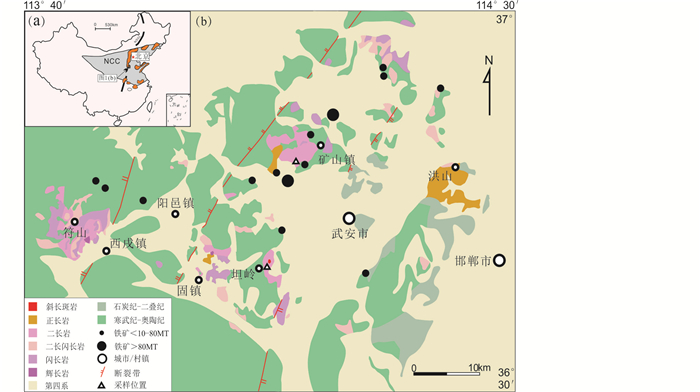
|
图 1 华北克拉通(a)及研究区(b)区域地质图(据苏尚国等,2017;霍延安等,2019) Fig. 1 Regional geological maps of the North China Craton (a) and of the study area (b) (after Su et al., 2017; Huo et al., 2019) |
斑状角闪二长岩为灰白色,具似斑状结构(图 2a),块状构造。斑晶为角闪石,野外可见斑晶具有一定的定向性。角闪石斑晶浅黄色-褐色(图 2a, b, d, e),粒径一般为2~8mm左右,含量10%~20%,部分发育环带结构。基质矿物主要为斜长石、钾长石、角闪石、黑云母、辉石和少量石英等(图 2c, f, h),副矿物有磷灰石、磁铁矿、钛铁矿、榍石、锆石(图 2h)等。
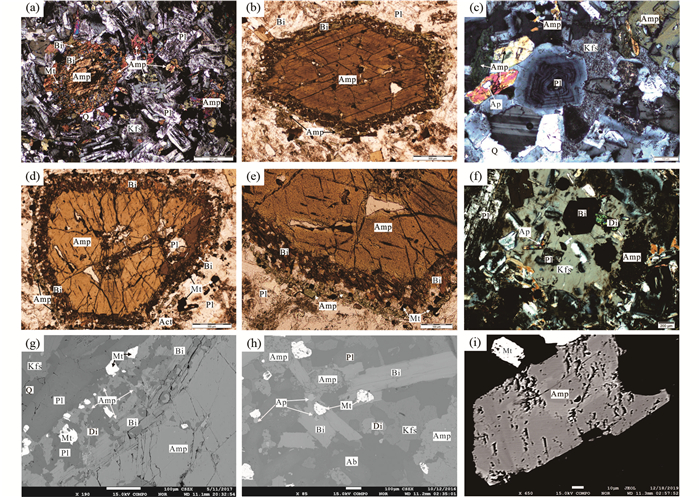
|
图 2 武安地区斑状角闪二长岩岩相学特征 (a)斑状角闪二长岩结构特征(+);(b)褐色斑晶角闪石边部发育反应环边,主要为弯曲状黑云母和绿色角闪石,基质黑云母较自形(-);(c)基质中主要矿物为环带斜长石,基质褐色较自形角闪石、基质绿色角闪石,钾长石等(+);(d)斑晶角闪石反应环边具圈层结构,内部也有裂隙与基质相连(-);(e)斑晶角闪石的环边圈层,从内向外分为三层(-);(f)基质中晚期他形钾长石包裹早期透辉石、角闪石、黑云母、斜长石、磷灰石等矿物(+);(g)斑晶角闪石环边结构:从内而外依次为:褐色角闪石、黑云母带、斜长石+透辉石带、绿色角闪石+磁铁矿带(BSE);(h)基质中矿物组合特征(BSE);(i)基质角闪石,出现成分的明暗变化,分别对应基质褐色和绿色角闪石.(+)正交偏光; (-)单偏光;(BSE)背散射图像. Amp-角闪石;Bi-黑云母;Pl-斜长石;Kfs-钾长石;Q-石英;Mt-磁铁矿;Ap-磷灰石;Ab-钠长石;Act-阳起石;Di-透辉石 Fig. 2 Petrography of amphibole monzodiorite porphyry in Wuan area |
斑状角闪二长岩中斑晶角闪石一般为褐色,但其边部会有一些小的绿色角闪石(图 2d, e);基质角闪石大部分都是他形的绿色角闪石(图 2a, c),部分为自形-半自形的浅褐色角闪石(图 2c),还有一些较自形的基质角闪石核部为褐色,边部区域被改造为绿色,在背散射下成明暗变化(图 2i);角闪石斑晶周围一般都有反应环边,按反应程度由内而外依次为黑云母带、透辉石和斜长石带、斑晶边部绿色角闪石和磁铁矿带(图 2d, e);角闪石斑晶中心一般都发生裂解,并与外部基质通过裂隙相连,内部发育各种矿物组合(图 2d):钠长石、斜长石、磷灰石、榍石、磁铁矿等。斜长石斑晶含量较少,普遍发育环带结构(图 2c);基质斜长石一般不会产生蚀变,只是呈长条状分布于基质中。钾长石他形,包裹着早期的自形晶矿物(图 2c, f)。部分斜长石内部被溶蚀为黑色,外部发育净边结构(图 2f); 黑云母褐色,半自形长条状或叶片状,主要为基质中的自形黑云母(图 2f, h)和角闪石边部的他形黑云母(图 2a, b, d, e);辉石大部分为他形粒状(图 2h);磁铁矿零星的分布在基质中或者环绕在角闪石斑晶边部(图 2e, g)。
3 分析方法对角闪石等矿物的电子探针(EMPA)成分分析在中国冶金地质总局山东局测试中心利用配备有四道波谱仪的JEOL JXA-8230型电子探针显微分析仪完成。工作条件为:15kV的加速电压,20nA的加速电流,束斑直径为1~10μm。Na、Mg、Al、Si、K、Ca、Fe元素特征峰的测量时间为10s,Ti和Mn元素特征峰的测量时间为20s,上下背景的测量时间分别是峰测量时间的一半。所有的测试数据都采用ZAF修正方法。标样为美国SPI矿物,金属标准和国家标准样品GSB。
矿物原位微量元素分析在合肥工业大学资源与环境工程学院矿床成因与勘查技术研究中心(OEDC)矿物微区分析实验室利用激光剥蚀电感耦合等离子体质谱仪(LA-ICP-MS)完成。激光剥蚀系统为Cetac Analyte HE,ICP-MS为Agilent7900。点剥蚀频率为8Hz,剥蚀束斑直径为30μm,能量密度为2J/cm2。激光剥蚀信号时间为40s,前后各有20s背景信号和空白信号。矿物微量元素处理采用无内标多外标方法进行,外标玻璃为GSE-1G、GSD-1G和BCR-2G。
4 分析结果 4.1 角闪石的主量元素特征对斑状角闪二长岩的角闪石进行了主量元素分析(表 1),角闪石整体比较富镁(Mg#>0.59)。其中褐色斑晶角闪石的成分主要为镁绿钙闪石和韭闪石(图 3),褐色基质角闪石是镁绿钙闪石;绿色基质角闪石主要成分是镁角闪石、浅闪石和阳起石,和斑晶反应边部的绿色颗粒角闪石成分一样。角闪石的主量元素成分(表 1)和哈克图解(图 4)可以看出角闪石的成分变化:褐色斑晶角闪石是低硅高铝的(SiO2含量为39.88%~43.14%,Al2O3含量为10.41%~13.04%);褐色基质角闪石是中硅中铝的(SiO2含量为43.25%~44.23%,Al2O3含量为9.27%~10.11%),它们的成分和斑晶差别并不大;而绿色角闪石是高硅低铝的(SiO2含量为46.46%~51.63%,Al2O3含量为3.57%~5.55%)。总的来说,斑晶和基质的褐色角闪石是低硅高铝的,而斑晶边部以及基质的绿色角闪石是高硅低铝的。由此可见褐色角闪石成分一致,它们代表深部的结晶环境,而绿色角闪石成分一致,它们代表了浅部的结晶环境。因此,将斑晶褐色角闪石和自形-半自形的基质褐色角闪石统称为褐色角闪石;斑晶边部以及基质他形的绿色角闪石统称为绿色角闪石。

|
图 3 角闪石分类图(据Leake et al., 1997) Fig. 3 Classification of amphiboles(after Leake et al., 1997) |
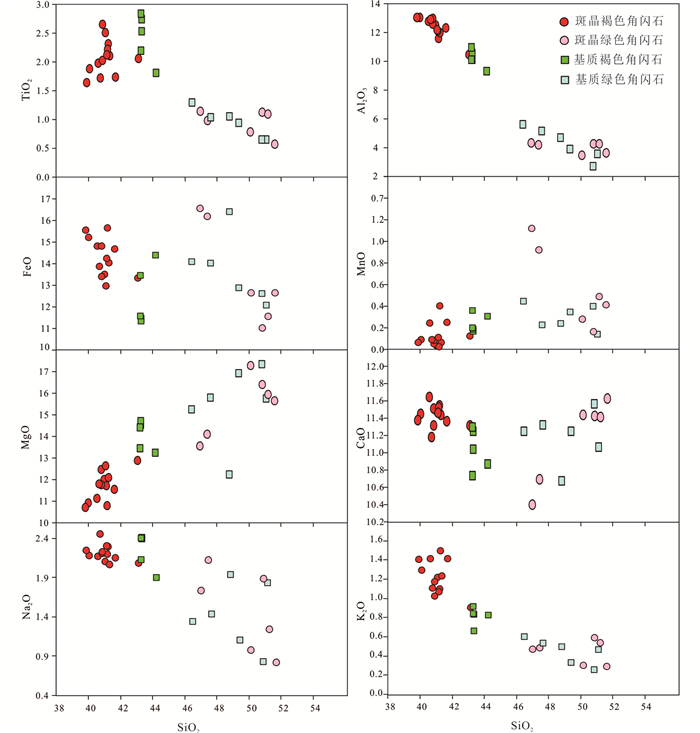
|
图 4 角闪石的主量元素成分变化图 Fig. 4 Major element compositions of amphiboles |
|
|
表 1 斑状角闪二长岩中角闪石电子探针计算结果(wt%) Table 1 Results of electron microprobe analysis of amphibole from amphibole monzodiorite porphyry (wt%) |
褐色角闪石相对绿色角闪石富TiO2、Na2O、K2O,贫MgO、MnO,它们之间的CaO含量差别不大;大部分绿色角闪石的FeO含量比褐色角闪石要低,但是有小部分绿色角闪石的FeO含量比较高(图 4)。
4.2 角闪石的微量元素特征角闪石的稀土和微量元素特征如表 2和图 5所示,斑晶褐色角闪石和基质褐色角闪石稀土和微量元素模式图比较一致,斑晶边部的绿色角闪石和基质绿色的角闪石总体来说稀土和微量特征具有相似的变化。褐色角闪石和绿色角闪石稀土元素上总体趋势比较一致,都是轻稀土相对富集,重稀土元素相对亏损的右倾曲线。褐色角闪石稀土总量高且比较集中,但是绿色角闪石稀土含量变化较大。部分绿色角闪石稀土总量很低,这可能是由于绿色角闪石结晶时周围的流体性质变化较大引起的;斑晶边部和基质中的绿色角闪石常和磷灰石、长石、榍石、磁铁矿等一起结晶析出,这也造成它们成分上具有更多变化。相对LREE和HREE,磷灰石、榍石的分离结晶会引起MREE的亏损(Hugh et al., 2000),因此绿色角闪石出现的MREE亏损可能是这些小角闪石常伴随磷灰石、榍石等结晶导致的。绿色角闪石具有明显的负Eu异常和岩浆晚期它们伴生长石大量结晶有关,因为长石分离结晶过程中会将Sr、Eu带走,导致了Eu的负异常。两类角闪石的微量元素的富集和亏损大体趋势一致,但是绿色角闪石具有更强的Nb、Sr、Pb、Ti的负异常。而且它们的Nb/Ta的比值差别很大,褐色角闪石Nb/Ta(20.9~39.6)要比绿色角闪石的Nb/Ta(16.6~193)小的多(表 2)。褐色角闪石具有Th、U的负异常,而绿色角闪石正好相反,它的Th、U含量较高,这可能由于岩浆演化晚期Th、U浓度增加引起的。
|
|
表 2 斑状角闪二长岩中角闪石稀土和微量元素分析结果(×10-6) Table 2 Trace element data in amphibole from amphibole monzodiorite porphyry (×10-6) |
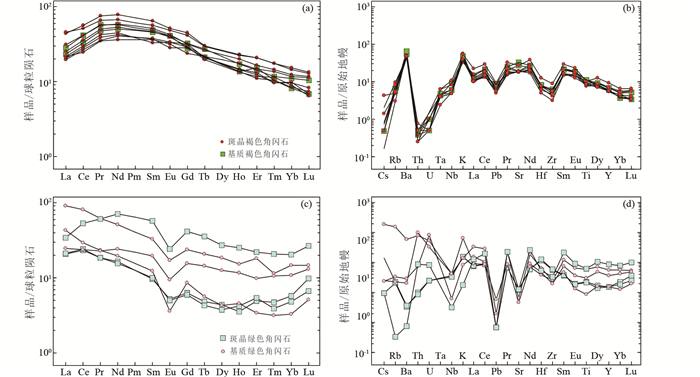
|
图 5 角闪石球粒陨石标准化稀土元素配分图(a、c)和原始地幔标准化微量元素蛛网图(b、d)(标准化值据Sun and McDonough, 1989) Fig. 5 Chondrite-normalized rare earth element patterns(a, c) and primitive mantle-normalized spider diagram(b, d) of amphiboles(normalization values after Sun and McDonough, 1989) |
武安杂岩体中钙质岩浆角闪石是比较常见的暗色矿物,且成分变化较大,可以有效的记录角闪石结晶时的温度、压力和岩浆的成分变化(Erdmann et al., 2014; Putirka, 2016)。前人根据角闪石中的全铝含量与结晶压力之间良好的线性关系, 提出的全铝压力计以及斜长石-角闪石温度计(Holland and Blundy, 1994; Schmidt, 1992; Anderson and Smith, 1995; Shane and Smith, 2013),上述温压计在花岗质岩石近固相线条件下误差较小,需要特定的矿物共生组合和成分限定(Anderson, 1996;李小伟等, 2011;汪洋, 2014; Putirka, 2016; Ridolfi et al., 2018),尤其不能计算基质小颗粒角闪石和斑晶边部绿色小角闪石(牛利峰和张宏福, 2005)。Ridolfi et al. (2010)根据实验提出了基于与俯冲相关的钙碱性火山岩中新的角闪石温压计、氧逸度和岩浆含水量计算公式,适用于Al# (VIAl/Altot)≤0.21和Mg2+/(Fe2++Mg2+)>0.5的角闪石,并在2012年对其进行了重新的修订,扩大了它的适用范围(Ridolfi and Renzulli, 2012)。随后该温压计得到大量应用(Zhang et al., 2015; Li et al., 2016; Duan et al., 2017; Gorini et al., 2018;龚林等, 2018; Xiong et al., 2019),并且计算基质小颗粒角闪石和斑晶边部绿色角闪石的结果也和其它矿物温压计结果一致(Zhang et al., 2015)。因此本文利用Ridolfi et al. (2010)钙质角闪石温压计公式,计算出不同角闪石形成的温度、压力值并进行投图(图 6),显示角闪石形成于三个阶段:褐色斑晶角闪石大多形成于相对高压(400~560MPa)和高温(950~980℃)的条件;褐色基质角闪石形成压力比斑晶角闪石降低(200~300MPa),而温度变化不大(870~940℃),是岩浆接近固结时快速结晶形成的;绿色角闪石都形成于相对低压(< 100MPa)和低温(700~880℃)的条件下,它们是在岩浆侵位到浅部时结晶的。
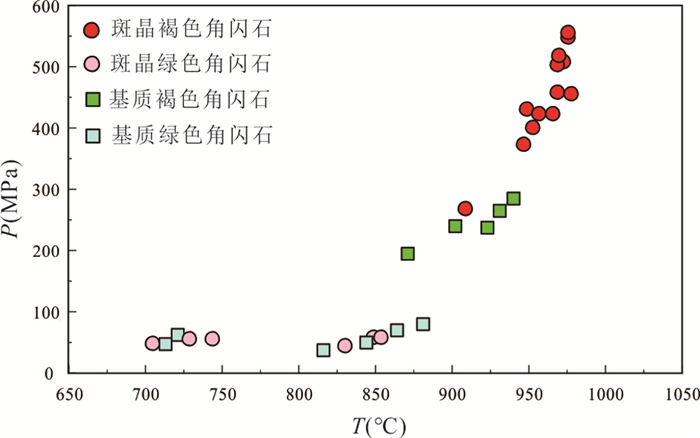
|
图 6 角闪石形成的温压图(据Ridolfi et al., 2010) Fig. 6 The temperature-pressure diagram of amphibole (after Ridolfi et al., 2010) |
根据地壳密度2.7g/m3,我们可以计算出角闪石的结晶深度。结果显示褐色斑晶角闪石形成深度为15~20km的岩浆房,褐色基质角闪石深度大约为7~10km的岩浆房,大部分基质和斑晶的绿色角闪石形成于岩浆定位深度(1~3km)条件下。目前多重岩浆房系统已经得到普遍认同(Marsh, 2004; Cashman et al., 2017; Segall, 2019; Sparks et al., 2019),武安地区不同角闪石的结晶压力也可以表明该区深部存在两个岩浆房系统,分别为15~20km的深部岩浆房和7~10km的浅部岩浆房。武安地区存在两期大的岩浆活动,分别为早期的等粒岩套和晚期的似斑状岩套(刘璐璐等, 2019;霍延安等, 2019;蒋俊毅等, 2020),该区大量暗色微粒包体和围岩捕掳体的存在(刘璐璐等, 2017;霍延安等, 2019;崔晓亮, 2020)都是深部发生岩浆混合和地壳混染作用的证据。同时武安地区不同类型的角闪石环带结构和不同斜长石晶体群的出现都被认为是深部存在多重岩浆房和发生多期次岩浆混合的产物(刘璐璐等, 2019;崔晓亮, 2020)。
褐色斑晶角闪石在深部岩浆房大量结晶,当岩浆逐渐演化上升到浅部岩浆房时褐色基质角闪石形成,尤其大量半自形基质角闪石的结晶说明岩浆房已经处于开始降温的状态并快速结晶的结果,此时岩浆接近固结-半固结,失去了上升侵位的能力(Caricchi et al., 2007)。从图 6我们可以看出在3~7km结晶的角闪石很少,说明该岩浆后来发生活化并进行快速的侵位,直到它在地壳浅部定位后大量他形的绿色基质角闪石和斑晶边部的绿色角闪石才又大量结晶。固结-半固结岩浆如何在高粘度下快速侵位到地壳浅部是一个重要问题。前人在该区研究也发现了一个冻结岩浆房活化机制可以很好解释这一问题。刘璐璐等(2017)在研究该区发现含70vol%斜长石斑晶的斜长斑岩的脉体,基质由蓝透闪石、条纹长石、石英,钾长石和钠长石,及少量磁铁矿、赤铁矿、钛铁矿、磷灰石、榍石和锆石等流体晶矿物组成,其成因被认为是深部半固结岩浆房在碱性富铁流体的加入下导致冻结岩浆房活化后快速侵入上地壳的。根据冻结岩浆房活化机制(罗照华等, 2014),该区斑状角闪二长岩的快速侵位可能也是在外来流体注入的情况下实现的。
5.2 岩浆氧逸度和含水量的演化相对于温度、f(H2O)和压力,体系的氧逸度对硅酸盐矿物的影响最显著,硅酸盐矿物的(Fe/Fe+Mg)随着氧逸度的增加将显著降低,将对硅酸盐矿物的化学组成产生重要的影响(Anderson and Smith, 1995)。角闪石的成分可以用来推断其形成时相应熔体的氧逸度及水的含量(Ridolfi et al., 2010)。经过计算可知角闪石都处在高氧逸度条件下(△NNO~△NNO+2)(表 1)。而且从图 7中我们可以看出,从褐色角闪石到绿色角闪石,氧逸度还有一个的升高的趋势。角闪石氧逸度的继续升高,反映了岩浆晚期岩浆系统氧逸度的升高。而岩浆体系后期更高氧逸度的出现可能是多期次的岩浆混合和地壳混染导致的(Zhang et al., 2015)。
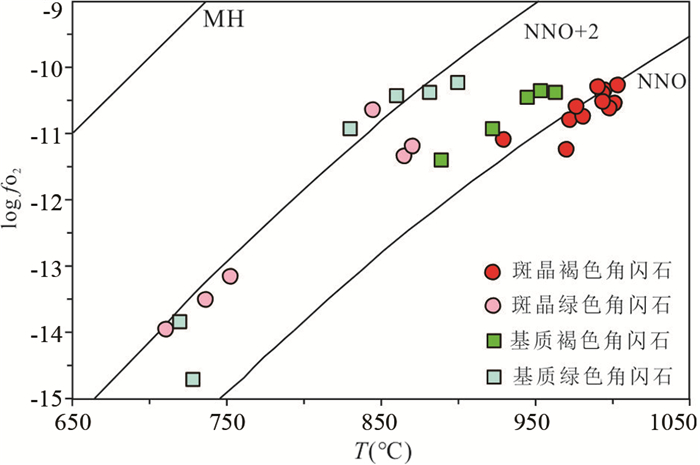
|
图 7 角闪石结晶时岩浆的温度-氧逸度变化图 Fig. 7 Magma' oxygen fugacity and temperature when amphibole crystallized |
同样利用Ridolfi et al. (2010)岩浆含水量计算公式计算角闪石结晶时熔体的含水量(表 1)。褐色斑晶角闪石结晶时的深部岩浆房含水量高(4.7%~6.5%)、褐色基质角闪石形成的浅部岩浆房含水量降低(4.2%~4.6%)、而绿色角闪石结晶时的岩浆含水量很低(2.1%~4.0%)。斑晶角闪石结晶时深部岩浆房的水含量很高,这为含水矿物角闪石的提前稳定结晶提供了条件;褐色基质角闪石的含水量降低说明岩浆房演化后期开始固结的表现。由于水在熔体中的溶解度与压力成正比(Cline, 1995),深部富水岩浆快速侵入到浅部地壳,压力也迅速降低,岩浆就由水不饱和熔体转化为水饱和熔体(图 8),从而导致大量流体出溶。此时岩浆中水含量降低,结晶出来的绿色角闪石的含水量也就降低了。深部多重岩浆房活动必然伴随着大量的流体活动,每一次岩浆房快速上升过程中都会有大量的流体出溶,多期次的岩浆活动会造成大量的深部流体出溶。
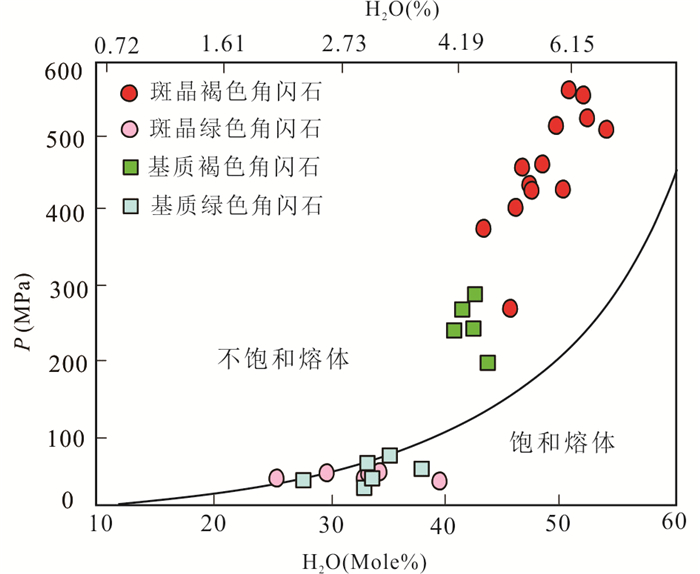
|
图 8 水含量和压力二元图(据Cline, 1995) 图中曲线为在1100℃下花岗闪长质熔体中水含量 Fig. 8 Water content versus pressure diagram (after Cline, 1995) |
对于矽卡岩型铁矿而言,岩浆的氧逸度对铁矿具有重要影响。高氧逸度的条件有利于铁矿的生成,这是因为高氧逸度条件有利于金属元素进入流体相,阻止其以硫化物的形式在早期沉淀,为后期的铁矿化提供了必要条件(Meinert, 1995)。岩浆演化后期绿色角闪石的更高氧逸度条件为最后成矿流体的出溶提供了保证。同时,岩浆中高的含水量也可以促使铁质的富集,高含量水的岩浆更容易在低压条件下出溶含矿流体(Cline, 1995; Robb, 2005)和挥发分。在早期阶段含水流体的出溶可以阻止金属元素的缺失,以便在后期阶段铁矿的大量沉淀(Mustard et al., 2006)。而斑状角闪二长岩中大量角闪石、黑云母等富水富挥发分的矿物,暗示武安地区富水岩浆在分离结晶过程中分离出大量的挥发份。这些挥发分虽然含量不高却极容易与铁、铜等金属元素形成易溶络合物,有利于成矿元素的富集和迁移(鲍新尚等, 2017)。
5.3 含矿流体的性质及成因角闪石在岩浆上升或岩浆混合过中受到加热时尤其对岩浆含水量和外界温度敏感,当岩浆上升至地表在高水压下富水稳定的角闪石由于周围熔体的排气作用而分解产生裂纹(Okamoto and Toriumi, 2005)。褐色斑晶角闪石内部破裂并与外部基质连通(图 2d),说明岩浆经历了快速上升或者混合的过程。岩浆在快速上升的过程中、角闪石和热的基性岩浆混合会在角闪石周围形成反应边(Browne et al., 2003; De Angelis et al., 2015),角闪石的反应边宽度大小还和岩浆上升速率成正比(Rutherford and Hill, 1993; Browne and Gardner, 2006),斑晶角闪石周围大量反应边表明岩浆上升速度很快。但是通过分析发现单纯加热降压过程中出现的角闪石反应边部并没有黑云母的出现(Rutherford and Hill, 1993; Browne et al., 2003; Browne and Gardner, 2006; De Angelis et al., 2015)。本次研究的斑晶角闪石边部都有富钾矿物黑云母的出现(图 2a, b, d, e),这说明斑晶角闪石不仅仅经历了岩浆快速上升过程,还可能受到富钾流体的交代作用。对于褐色基质角闪石,其背散射图中也有不同明暗程度的变化(图 2i),从亮色到暗色的变化也是一个明显的流体交代的过程。褐色角闪石和绿色角闪石的微量元素化学成分上也可以体现一个流体的交代过程。一般来说不相容元素在岩浆演化的晚期富集,随着岩浆的持续的分馏,熔体中不相容元素含量就增加了(Smith, 2014)。但是我们可以看到岩浆结晶后期的绿色角闪石反而比早期褐色角闪石不相容元素降低,尤其是K、Rb、Ba、Sr等大离子亲石元素,可能是这些褐色角闪石上升时和流体发生反应,侵位到浅部后伴随流体的大量出溶形成绿色角闪石等矿物,大离子亲石元素随流体迁移而导致绿色角闪石不相容元素降低。
同时,角闪石Nb/Ta值都比原始地幔和大陆地壳要高,绿色角闪石的Nb、Ta值比褐色角闪石降低但是Nb/Ta升高,有的高达193(表 2)。一般造成Nb/Ta分异的深部地质过程主要有流(熔)体和岩浆相互作用(Green, 1995; Dostal and Chatterjee, 2000)、热迁移作用和一些特殊的岩浆活动(丁兴和孙卫东, 2014),而绿色角闪石经历的更多的是岩浆与流体的相互作用。Green (1994)认为岩浆演化后期的流体促使分异晚期的岩浆更容易富集Ta而不是Nb,使得岩浆的Nb/Ta比值随着演化程度的增加而降低。这说明绿色角闪石的高的Nb/Ta并不是岩浆演化晚期正常的值,而必然受到来自深部的外来流体交代作用。
虽然在岩浆分异过程中可以产生流体,但是由于熔体与流体产量的关系,成矿所需的巨量流体并不能只通过深部岩体的岩浆分异作用产生(罗照华等, 2014)。因此,除了同源岩浆分异流体之外,成矿岩浆中还含有额外的、更深源的流体加入(Scoates and Mitchell, 2000),它们可能是一种透岩浆流体(罗照华等, 2008),因为地球内部甚至地核中含有大量的流体(Yang and Scott, 2005; Li et al., 2020),这些深部的流体就可能携带大量成矿物质而活化冻结的岩浆房,之后快速侵位造成更多流体出溶成矿。
斑晶角闪石在快速侵位过程中,与外来含矿流体反应形成反应环边。我们根据角闪石反应环边不同矿物化学成分进行分析,得出和角闪石反应的流体性质及具体过程如下:
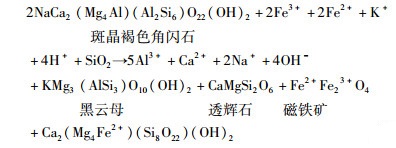
|
(1) |
绿色角闪石
通过反应公式(1)我们可以看出,褐色斑晶角闪石在富钾富铁富硅流体作用下生成黑云母、透辉石、磁铁矿和绿色角闪石的矿物组合,剩余离子则富流体迁移或者生成钠长石和斜长石。正是该含矿流体的注入使固结-半固结的岩浆房活化并快速上升,上升过程中斑晶角闪石和流体发生反应,流体的注入也使岩浆中含水量升高,为侵位后成矿流体的大量出溶准备了条件。
5.4 对邯邢铁矿的成因指示邯邢地区矽卡岩铁矿的致矿侵入体都发育强烈的钠钙质蚀变,传统的矽卡岩接触交代成因模式认为铁质来源主要是岩浆分异形成的岩浆期后热液以及浅部岩浆中的暗色矿物析出铁质(沈保丰等, 1977, 1979, 1981;刘英俊等, 1982;赵一鸣等, 1983;郑建民, 2007)。但是Barton and Johnson (1996)和Dilles and Einaudi (1992)认为这种大范围的钠钙质蚀变是由岩浆热源驱动的外部流体与致矿侵入体中的长石发生反应的结果,所以岩体中析出的铁是否能够提出磁铁矿的铁质来源还存在问题。实际观察表明导致矽卡岩形成的流体可能直接来自其附近的火成岩侵入体,但是从质量平衡的角度看,直接侵入体并不能提供足够的高温含矿流体(石准立等, 1983)。根据成矿金属在流体中溶解度的实验结果,成矿金属在流体中的溶解度与温度、压力正相关(Loucks and Mavrogenes, 1999),只有深部流体才具有较大的成矿潜力(罗照华等, 2007)。Meinert et al. (2005)也认为矽卡岩铁矿床的成矿流体主要来自与之相关的侵入体,但随着成矿作用的演化,可能有大量的外部流体和其他组分加入到成矿体系中,这从大量稳定同位素和流体包裹体得到证据(Pons et al., 2009; Zürcher et al., 2001)。还有部分学者认为岩体中析出的铁不足以形成大的矿床,岩体中析出的铁也不能平衡磁铁矿同位素的变化(陈永健等, 2014),必须有岩浆流体带来的铁才能平衡(侯通等, 2010; Zhu et al., 2016)。矽卡岩铁矿成矿过程中否有外来含矿流体的参与是必须厘清的一个问题。为此,我们从斑晶角闪石反应边这个析铁反应过程来直接分析角闪石和流体反应前后是否达到铁质质量平衡。
图 9为发育反应边的角闪石斑晶(图 2d)的素描图,我们利用晶体粒度分析方法(CSD)(杨宗锋等, 2010)计算出角闪石斑晶反应环带上不同矿物所占的面积比,在这个截面上等同于它们的体积比。利用各矿物FeOT平均含量计算出斑晶角闪石反应前后含铁量的变化,由表 3计算结果我们可以看出反应后整体含铁量明显增加。结合角闪石反应环边反应(1)的结果,我们可以得出结论:单纯靠岩浆中的暗色矿物析出的铁不能达到磁铁矿的质量平衡,外来富铁流体加入到成矿体系是必须的。斑晶角闪石周围的磁铁矿绝大多数是围绕在它的周围,并没有发生搬运,即使铁质来源是完全靠角闪石等暗色矿物析出的铁,也未表现出聚集成矿的特征。外来含矿流体的加入,无论是对于岩浆房的活化和快速上升,还是对于斑晶角闪石反应环边的铁质质量平衡都是必须的。外部含矿流体的注入提高了岩浆中的含水量,致使固结-半固结岩浆房活化并快速上升,压力迅速降低,高氧逸度条件下成矿流体大量出溶。同时,岩浆快速上升将避免含矿流体因热力学平衡而在运动途中丢失成矿金属,定位后必然发生大规模成矿作用(罗照华等, 2014)。
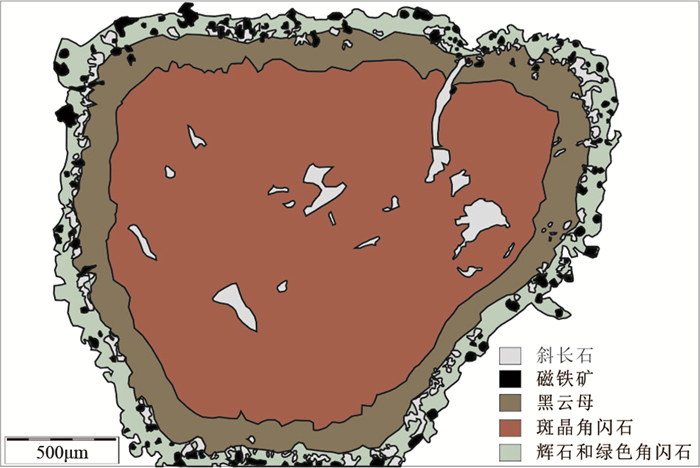
|
图 9 斑晶角闪石及其反应环边素描图 Fig. 9 A drawing diagram of amphibole phenocryst and its reaction rim |
|
|
表 3 角闪石斑晶反应前后含铁量变化计算表 Table 3 The calculation table of the iron content of amphibole phenocryst before and after the reaction process |
“邯邢式”铁矿的成因模式可能不是传统的热液接触交代成因模型,矽卡岩铁矿的铁质来源应该是深部含矿流体,它可以进一步演化为“含铁熔体-流体”或“铁矿浆”。前人研究发现“铁矿浆”中可能含有大量挥发分流体(陈永健等, 2014;苏尚国等, 2015),并不是单纯的矿浆,这就解决了它比重大上升难的问题。苏尚国等(2015)据此提出“含铁熔体-流体通道成矿系统”成矿模型(图 10),认为铁矿浆在深部CO2及高盐度流体的加入下,在深部岩浆房产生流体超压环境,形成“含铁熔体-流体”,“含铁熔体-流体”沿通道(构造薄弱带)快速上侵就位成矿。武安玉石洼铁矿的磁铁矿的化学成分从深部到浅部具有从高钛向高硅的演化趋势(侯晓阳等, 2019),一般高钛磁铁矿在早期高温岩浆中的结晶产物(Buddington and Lindsley, 1964),而高硅磁铁矿被认为是高挥发分和高流动性组分的特征(Shcheka et al., 1977)。玉石洼铁矿的磁铁矿成分变化反映了从矿浆成因过渡到流体成因的连续变化过程,表明“含铁熔体-流体”就位的温度、压力条件控制磁铁矿的成分特征及其矿物共生组合(侯晓阳等, 2019)。该模型能够很好的解释包括矿浆型磁铁矿在内的不同类型的磁铁矿的成因以及不同类型角闪石的成因,也强调了外来含矿流体加入和岩浆快速侵位的必要性。

|
图 10 “含铁熔体-流体通道成矿系统”成矿模型图(据苏尚国等,2015;侯晓阳等, 2019) (a)在深部岩浆房,中性-基性岩浆与碳酸盐岩反应形成铁矿浆;(b)由于铁矿浆比重大,铁矿浆在岩浆房底部聚集;(c)由于CO2气体和深部高盐度流体的加入,深部岩浆房产生了流体超压的环境,流体与铁矿浆结合使其密度变轻,形成含铁熔体-流体;(d)含铁熔体-流体沿通道(构造薄弱带)上侵就位 Fig. 10 The metallogenic diagrammatic figure of "Iron-enriched melt-fluid channel metallogenic system" (after Su et al., 2015; Hou et al., 2019) |
因此,武安地区斑状角闪二长岩的褐色角闪石斑晶在15~20km的深部岩浆房结晶,之后在岩浆侵位到7~10km的浅部岩浆房时褐色基质角闪石结晶,此时岩浆房接近固结-半固结状态。随后深部外来碱性富硅富铁流体注入发生岩浆房的活化,岩浆快速侵位并在1~3km处定位,大量绿色基质角闪石形成,此时压力迅速降低使更多成矿流体出溶。这个过程中角闪石和流体发生反应,褐色角闪石斑晶和流体反应生成反应环边的绿色角闪石,褐色基质角闪石也大部分被交代为绿色角闪石。外来富铁流体的注入使岩浆快速侵位,高含水量和高氧逸度条件下成矿流体大量出溶,这些因素共同促进矽卡岩铁矿的形成。
6 结论(1) 武安地区斑状角闪二长岩中角闪石主要分为两类:褐色角闪石和绿色角闪石。褐色角闪石形成于高温高压富水高氧逸度的深部岩浆中,绿色角闪石是在低温低压低含水量更高氧逸度的条件下形成的。相对于褐色角闪石,绿色角闪石具有更强的Nb、Sr、Pb、Ti的负异常和极高Nb/Ta值,这代表绿色角闪石是在流体的交代作用下形成的。
(2) 通过斑晶角闪石反应环边化学成分分析和计算,外来富铁流体的加入是必须的。邯邢式铁矿的成因并不是热液接触交代成因,矽卡岩铁矿的铁质来源应该是深部含矿流体。
(3) 外来碱性富硅富铁流体的注入使岩浆快速侵位,高含水量和高氧逸度条件下成矿流体大量出溶,这些因素共同促进矽卡岩铁矿的形成。
致谢 本次样品测试工作得到中国冶金地质总局山东局测试中心林培军、李增胜的帮助和合肥工业大学汪方跃老师的指导;审稿专家对文章的不足提出了有益的修改意见;在此一并表示感谢!
Anderson JL and Smith DR. 1995. The effects of temperature and fO2 on the Al-in-hornblende barometer. American Mineralogist, 80: 549-559 |
Anderson JL. 1996. Status of thermobarometry in granitic batholiths. Earth and Environmental Science Transactions of the Royal Society of Edinburgh, 87(1-2): 125-138 |
Bao XS, He WY and Gao X. 2017. The Beiya gold deposit:Constraint from water-rich magmas to mineralization. Acta Petrologica Sinica, 33(7): 2175-2188 (in Chinese with English abstract) |
Barton MD and Johnson DA. 1996. Evaporitic-source model for igneous-related Fe oxide (REE-Cu-Au-U) mineralization. Geology, 24(3): 259 |
Bi XW, Hu RZ, Hanley JJ, Mungall JE, Peng JT, Shang LB, Wu KX, Yan S, Li HL and Hu XY. 2009. Crystallisation conditions (T, P, fO2) from mineral chemistry of Cu- and Au-mineralised alkaline intrusions in the Red River-Jinshajiang alkaline igneous belt, western Yunnan Province, China. Mineralogy and Petrology, 96(1): 43-58 |
Breiter K, Sokolová M and Sokol A. 1991. Geochemical specialization of the tin-bearing granitoid massifs of NW Bohemia. Mineralium Deposita, 26(4): 298-306 |
Browne BL, Gardner JE and Larsen J. 2003. Amphibole reaction rims in response to decompression compared to heating: An experimental approach. In: Proceedings of American Geophysical Union, Fall Meeting 2003. American Geophysical Union, 84(46): Abstract V12A-0551
|
Browne BL and Gardner JE. 2006. The influence of magma ascent path on the texture, mineralogy, and formation of hornblende reaction rims. Earth and Planetary Science Letters, 246(3-4): 161-176 |
Buddington AF and Lindsley DH. 1964. Iron-titanium oxide minerals and synthetic equivalents. Journal of Petrology, 5(2): 310-357 |
Caricchi L, Burlini L, Ulmer P, Gerya T, Vassalli M and Papale P. 2007. Non-Newtonian rheology of crystal-bearing magmas and implications for magma ascent dynamics. Earth and Planetary Science Letters, 264(3-4): 402-419 |
Cashman KV, Sparks RSJ and Blundy JD. 2017. Vertically extensive and unstable magmatic systems:A unified view of igneous processes. Science, 355(6331): eaag3055 |
Chen B, Tian W, Zhai MG and Arakawa Y. 2005. Zircon U-Pb geochronology and geochemistry of the Mesozoic magmatism in the Taihang Mountains and other places of the North China craton, with implications for petrogenesis and geodynamic setting. Acta Petrologica Sinica, 21(1): 13-24 (in Chinese with English abstract) |
Chen B, Chen CJ, He JB and Liu AK. 2013. Origin of Mesozoic high-Mg adakitic rocks from northeastern China:Petrological and Nd-Sr-Os isotopic constraints. Chinese Science Bulletin, 58(20): 1941-1953 (in Chinese) |
Chen YJ, Su SG, He YS, Li SG, Hou JG, Feng SC and Cao K. 2014. Fe isotope compositions and implications on mineralization of Xishimen iron deposit in Wuan, Hebei. Acta Petrologica Sinica, 30(11): 3443-3454 (in Chinese with English abstract) |
Cline JS. 1995. Genesis of porphyry copper deposits: The behavior of water, chloride, and copper in crystallizing melts. In: Pierce FW and Bohm JG (eds.). Porphyry Copper Deposits of the American Cordillera. Tucson: Arizona Geological Society, 69-82
|
Cui XL. 2020. Deep magmatism processes and shallow response of the Early Cretaceous intrusive rocks in Han-Xing district, Hebei Province, China. Ph. D. Dissertation. Beijing: China University of Geosciences (Beijing), 1-141 (in Chinese with English summary)
|
De Angelis SH, Larsen J, Coombs M, Dunn A and Hayden L. 2015. Amphibole reaction rims as a record of pre-eruptive magmatic heating:An experimental approach. Earth and Planetary Science Letters, 426: 235-245 |
Dilles JH and Einaudi MT. 1992. Wall-rock alteration and hydrothermal flow paths about the Ann-Mason porphyry copper deposit, Nevada:A 6-km vertical reconstruction. Economic Geology, 87(8): 1963-2001 |
Ding X and Sun WD. 2014. Nb/Ta differentiation and diagenesis and mineralization significance of deep earth processes: From micro to macro. In: Annual Meeting of Chinese Geoscience Union. Beijing: Chinese Geophysical Society, Organizing Committee of the National Symposium on Petrology and Geodynamics, Special Committee of Structural Geology and Geodynamics, Chinese Geological Society, Regional Geology and Metallogeny Committee of Chinese Geological Society, 2114-2114 (in Chinese)
|
Dostal J and Chatterjee AK. 2000. Contrasting behaviour of Nb/Ta and Zr/Hf ratios in a peraluminous granitic pluton (Nova Scotia, Canada). Chemical Geology, 163(1-4): 207-218 |
Duan DF and Jiang SY. 2017. In situ major and trace element analysis of amphiboles in quartz monzodiorite porphyry from the Tonglvshan Cu-Fe (Au) deposit, Hubei Province, China:Insights into magma evolution and related mineralization. Contributions to Mineralogy and Petrology, 172(5): 36 |
Erdmann S, Martel C, Pichavant M and Kushnir A. 2014. Amphibole as an archivist of magmatic crystallization conditions:Problems, potential, and implications for inferring magma storage prior to the paroxysmal 2010 eruption of Mount Merapi, Indonesia. Contributions to Mineralogy and Petrology, 167(6): 1016 |
Gong L, Chen HY, Xiao B, Wang YF and Zhao LD. 2018. Mineral chemistry of hornblende in the Chihu-Fuxing copper district, Xinjiang, and its geological significance. Geochimica, 47(2): 149-168 (in Chinese with English abstract) |
Gorini A, Ridolfi F, Piscaglia F, Taussi M and Renzulli A. 2018. Application and reliability of calcic amphibole thermobarometry as inferred from calc-alkaline products of active geothermal areas in the Andes. Journal of Volcanology and Geothermal Research, 358: 58-76 |
Green TH. 1994. Experimental studies of trace-element partitioning applicable to igneous petrogenesis-Sedona 16 years later. Chemical Geology, 117(1-4): 1-36 |
Green TH. 1995. Significance of Nb/Ta as an indicator of geochemical processes in the crust-mantle system. Chemical Geology, 120(3-4): 347-359 |
Hammarstrom JM and Zen EA. 1986. Aluminum in hornblende:An empirical igneous geobarometer. American Mineralogist, 71: 1297-1313 |
Holland T and Blundy J. 1994. Non-ideal interactions in calcic amphiboles and their bearing on amphibole-plagioclase thermometry. Contributions to Mineralogy and Petrology, 116(4): 433-447 |
Hou T, Zhang ZC and Du YS. 2010. Deep ore magma-hydrothermal system of Zhonggu ore field in southern part of Ningwu Basin. Earth Science Frontiers, 17(1): 186-194 (in Chinese with English abstract) |
Hou XY, Su SG and Yang YY. 2019. Magnetite characteristics of the Yushiwa iron deposit in Wu'an, Hebei Province and its indication significance to the genesis of iron deposit. Earth Science Frontiers, 26(6): 244-256 (in Chinese with English abstract) |
Hugh RR. 2000. Rock Geochemistry. In: Yang XM, Yang XY and Chen SX (Trans.). Hefei: Chinese University of Science and Technology Press, 109-110 (in Chinese)
|
Humphreys MCS, Cooper GF, Zhang J, Loewen M, Kent AJR, Macpherson CG and Davidson JP. 2019. Unravelling the complexity of magma plumbing at Mount St. Helens: A new trace element partitioning scheme for amphibole. Contributions to Mineralogy and Petrology, 174: 9
|
Huo YA, Su SG, Yang YB and Gu DP. 2019. The evidence for Lithospheric thinning of Mesozoic North China Craton:Taking Guzhen intrusive complex as an example. Acta Petrologica Sinica, 35(4): 989-1014 (in Chinese with English abstract) |
Jiang JY, Su SG, Cui XL, Liu LL, Meng WY and Wang JJ. 2020. The processes and mechanism of lithospheric thinning in eastern North China Craton during Early Cretaceous:Evidence from Xishimen Complex, Hebei Province. Acta Petrologica Sinica, 36(2): 356-390 (in Chinese with English abstract) |
Leake BE, Woolley AR, Arps CES, Birch WD, Gilbert MC, Grice JD, Hawthorne E, Kato A, Kisch HJ, Krivovichev VG, Linthout K, Laird J, Mandarino J, Maresch WV, Nickel EH, Rock NMS, Schumacher JC, Smith DC, Stephenson NCN, Whittaker EJW and Youzhi G. 1997. Nomenclature of amphiboles report of the Subcommittee on Amphiboles of the International Mineralogical Association Commission on New Minerals and Mineral Names. European Journal of Mineralogy, 9(3): 623-651 |
Li JX, Qin KZ, Li GM, Evans NJ, Zhao JX, Yue H and Xie J. 2018. Volatile variations in magmas related to porphyry Cu-Au deposits:Insights from amphibole geochemistry, Duolong district, central Tibet. Ore Geology Reviews, 95: 649-662 |
Li SR, Santosh M, Zhang HF, Shen JF, Dong GC, Wang JZ and Zhang JQ. 2013. Inhomogeneous lithospheric thinning in the central North China Craton:Zircon U-Pb and S-He-Ar isotopic record from magmatism and metallogeny in the Taihang Mountains. Gondwana Research, 23(1): 141-160 |
Li XW, Huang XF and Huang DF. 2011. Review on application of geobarometry for granitic rocks. Geological Journal of China Universities, 17(3): 415-422 (in Chinese with English abstract) |
Li XW, Mo XX, Scheltens M and Guan Q. 2016. Mineral chemistry and crystallization conditions of the Late Cretaceous Mamba pluton from the eastern Gangdese, Southern Tibetan Plateau. Journal of Earth Science, 27(4): 545-570 |
Li YG, Vočadlo L, Sun T and Brodholt JP. 2020. The Earth's core as a reservoir of water. Nature Geoscience, 13(6): 453-458 |
Li YH, Xie GQ, Duan C, Han D and Wang CY. 2013. Effect of sulfate evaporate salt layer over the formation of skarn-type iron ores. Acta Geologica Sinica, 87(9): 1324-1334 (in Chinese with English abstract) |
Lin XD, Yao SZ and Zhang SZ. 1984. A study on nature of ore-bearing fluids of "Daye Type" iron ore deposits in eastern Hubei, China. Earth Science, (4): 99-106 (in Chinese with English abstract) |
Lin XD. 1998. Geological characteristics of magma hydrothermal transitional ore deposits. Geoscience, 12(4): 485-492 (in Chinese with English abstract) |
Liu LL, Su SG, Hou JG and Xie YC. 2017. Genesis of Tanling plagioporphyry in Wuan, Hebei:The remobilizing mechanism of frozen magma chambers. Acta Petrologica Sinica, 33(1): 204-220 (in Chinese with English abstract) |
Liu LL, Su SG, Wang N and Wang WB. 2019. Deep magmatic processes and shallow responses during the lithospheric thinning of North China Craton:Taking Tanling intrusive complex as an example. Acta Petrologica Sinica, 35(9): 2873-2892 (in Chinese with English abstract) |
Liu YJ, Li ZL, Zhao MF and Jiang HS. 1982. Exrerimental studies on the formation conditions of rich iron-ore deposits of Hanxing-type in northern China. Journal of Nanjing University (Natural Sciences), (4): 917-927 (in Chinese with English abstract) |
Loucks RR and Mavrogenes JA. 1999. Gold solubility in supercritical hydrothermal brines measured in synthetic fluid inclusions. Science, 284(5423): 2159-2163 |
Luo ZH, Deng JF and Han XQ. 1999. On Characteristics of Magmatic Activities and Orogenic Process of Taihangshan Intraplate Orogen. Beijing: Geological Publishing House, 1-124 (in Chinese)
|
Luo ZH, Mo XX, Lu XX, Chen BH, Ke S, Hou ZQ and Jiang W. 2007. Metallogeny by trans-magmatic fluids:Theoretical analysis and field evidence. Earth Science Frontiers, 14(3): 165-183 (in Chinese with English abstract) |
Luo ZH, Lu XX, Guo SF, Sun J, Chen BH, Huang F and Yang ZF. 2008. Metallogenic systems on the transmagmatic fluid theory. Acta Petrologica Sinica, 24(12): 2669-2678 (in Chinese with English abstract) |
Luo ZH, Zhou JL, Hei XH, Liu C and Su SG. 2014. Post-supereruption (-superintrusion) metallogenesis. Acta Petrologica Sinica, 30(11): 3131-3154 (in Chinese with English abstract) |
Marsh B. 2004. A magmatic mush column Rosetta stone:The McMurdo dry valleys of Antarctica. Eos, Transactions American Geophysical Union, 85(47): 497-502 |
Meinert LD. 1995. Compositional variation of igneous rocks associated with skarn deposits-chemical evidence for a genetic connection between petrogenesis and mineralization. In: Thompson JFH (ed.). Mineralogical Association of Canada, Short Course Series. Nepean: Mineralogical Association of Canada, 401-418
|
Meinert LD, Dipple GM and Nicolescu S. 2005. World skarn deposits. In: Hedenquist JW, Thompson JFH, Goldfarb RJ and Richards JP (eds.). Economic Geology 100th Anniversary Volume 1905-2005. Amsterdam: Elsevier, 299-336
|
Mustard R, Ulrich T, Kamenetsky VS and Mernagh T. 2006. Gold and metal enrichment in natural granitic melts during fractional crystallization. Geology, 34(2): 85-88 |
Niu LF and Zhang HF. 2005. Mineralogy and petrogenesis of amphiboles from intermediate-mafic intrusions in southern Taihang Mountains. Geotectonica et Metallogenia, 29(2): 269-277 (in Chinese with English abstract) |
Okamoto A and Toriumi M. 2005. Progress of actinolite-forming reactions in mafic schists during retrograde metamorphism:An example from the Sanbagawa metamorphic belt in central Shikoku, Japan. Journal of Metamorphic Geology, 23(5): 335-356 |
Pei RF, Liu Y and Lü FX. 1985. A discussion on "Daye-type" iron deposit. Bulletin of Institute of Mineral Resources, Chinese Academy of Geological Sciences, 15: 6-17 (in Chinese) |
Peters STM, Troll VR, Weis FA, Dallai L, Chadwick JP and Schulz B. 2017. Amphibole megacrysts as a probe into the deep plumbing system of Merapi volcano, Central Java, Indonesia. Contributions to Mineralogy and Petrology, 172(4): 16 |
Pons JM, Franchini M, Meinert L, Recio C and Etcheverry R. 2009. Iron skarns of the Vegas peladas district, Mendoza, Argentina. Economic Geology, 104(2): 157-184 |
Putirka K. 2016. Amphibole thermometers and barometers for igneous systems and some implications for eruption mechanisms of felsic magmas at arc volcanoes. American Mineralogist, 101(4): 841-858 |
Ridolfi F, Puerini M, Renzulli A, Menna M and Toulkeridis T. 2008. The magmatic feeding system of El Reventador volcano (Sub-Andean zone, Ecuador) constrained by texture, mineralogy and thermobarometry of the 2002 erupted products. Journal of Volcanology and Geothermal Research, 176(1): 94-106 |
Ridolfi F, Renzulli A and Puerini M. 2010. Stability and chemical equilibrium of amphibole in calc-alkaline magmas:An overview, new thermobarometric formulations and application to subduction-related volcanoes. Contributions to Mineralogy and Petrology, 160(1): 45-66 |
Ridolfi F and Renzulli A. 2012. Calcic amphiboles in calc-alkaline and alkaline magmas:Thermobarometric and chemometric empirical equations valid up to 1, 130℃ and 2.2GPa. Contributions to Mineralogy and Petrology, 163(5): 877-895 |
Ridolfi F, Zanetti A, Renzulli A, Perugini D, Holtz F and Oberti R. 2018. AMFORM, a new mass-based model for the calculation of the unit formula of amphiboles from electron microprobe analyses. American Mineralogist, 103(7): 1112-1125 |
Robb L. 2005. Introduction to Ore-Forming Processes. Malden: Blackwell Publishing, 1-373
|
Rutherford MJ and Hill PM. 1993. Magma ascent rates from amphibole breakdown:An experimental study applied to the 1980-1986 Mount St. Helens eruptions. Journal of Geophysical Research, 98(B11): 19667-19685 |
Schmidt MW. 1992. Amphibole composition in tonalite as a function of pressure:An experimental calibration of the Al-in-hornblende barometer. Contributions to Mineralogy and Petrology, 110(2-3): 304-310 |
Scoates JS and Mitchell JN. 2000. The evolution of troctolitic and high al basaltic magmas in Proterozoic anorthosite plutonic suites and implications for the Voisey's bay massive Ni-Cu sulfide deposit. Economic Geology, 95(4): 677-701 |
Segall P. 2019. Magma chambers:What we can, and cannot, learn from volcano geodesy. Philosophical Transactions of the Royal Society A:Mathematical, Physical and Engineering Sciences, 377(2139): 20180158 |
Shane P and Smith VC. 2013. Using amphibole crystals to reconstruct magma storage temperatures and pressures for the post-caldera collapse volcanism at Okataina volcano. Lithos, 156-159: 159-170 |
Shcheka SA, Romanenko IM, Chubarov VM and Kurentsova NA. 1977. Silica-bearing magnetites. Contributions to Mineralogy and Petrology, 63(2): 103-111 |
Shen BF, Lu SN, Yu EZ, Shan LF and Yu JH. 1977. The characteristics of sodium metasomatism in magnetite deposits of a certain region and its prospecting significance. Scientia Geologica Sinica, 12(3): 263-274 (in Chinese with English abstract) |
Shen BF, Lu SN, Zhai AM, Li ZH and Yu EZ. 1979. Chemical composition and typomorphic characteristics of magnetite and its geological significance in contact metasomatic deposit of Henan Province. Geological Review, 25(1): 10-18 (in Chinese with English abstract) |
Shen BF, Zhai AM, Li ZH and Wang YL. 1981. The analysis of geological conditions for minera-lization of the iron deposits of Han-Xing subtype in southern Hebei. Acta Geologica Sinica, 55(2): 127-138 (in Chinese with English abstract) |
Shen JF, Santosh M, Li SR, Zhang HF, Yin N, Dong GC, Wang YJ, Ma GG and Yu HJ. 2013. The Beiminghe skarn iron deposit, eastern China:Geochronology, isotope geochemistry and implications for the destruction of the North China Craton. Lithos, 156-159: 218-229 |
Shi ZL, Jin ZM, Xiong PF, Wang DY and Huang KK. 1981. A preliminary discussion on problems of ore-magma mineralization of "Daye-type" iron deposit at Tieshan, Hubei. Earth Science, (2): 145-154 (in Chinese with English abstract) |
Shi ZL, Xiong PF, Wang DY, Jin ZM, Zhang ZG, Huang KK and Feng ZL. 1983. A preliminary discussion on problems of ore-magma mineralization of "Daye-type" iron deposit at Tieshan, Hubei. Geological Science and Technology Information, (Suppl.1): 30-39 (in Chinese) |
Smith DJ. 2014. Clinopyroxene precursors to amphibole sponge in arc crust. Nature Communications, 5: 4329 |
Sparks RSJ, Annen C, Blundy JD, Cashman KV, Rust AC and Jackson MD. 2019. Formation and dynamics of magma reservoirs. Philosophical Transactions of the Royal Society A:Mathematical, Physical and Engineering Sciences, 377(2139): 20180019 |
Su SG, Hou JG, Cui Y and Yang YQ. 2015. Magmatic conduit melt-fluid metallogenic system- A new Genetic Model for Xishimen iron deposit, Wuan area, Hebei Province, China. In: Proceedings of 2015 AGU Fall Meeting. American Geophysical Union, Abstract V23B-3156
|
Su SG, Hou JG, Luo ZH, Wu GY and Chen YJ. 2015. Genetic mechanism of skarn iron deposits-evidence from the Xishimen iron deposit in Wu'an, Hebei. Abstract Summary of the 15th Annual Academic Conference of the Chinese Society for Mineralogy, Petrology and Geochemistry, (2): 99-100 (in Chinese)
|
Su SG, Jian DC, Xie YC, Luo ZH, Jiang JY, Liu LL, Huo YA, Cui XL, Zhang B, Gu DP and Wang Y. 2017. The practice of thematic geological mapping in medium-large scale for intermediate-basic intrusive rocks:A case study of the Wu'an iron ore concentration area, Hebei Province. Geological Bulletin of China, 36(11): 1987-1998 (in Chinese with English abstract) |
Sun SS and McDonough WF. 1989. Chemical and isotopic systematics of oceanic basalts: Implications for mantle composition and processes. In: Saunders AD and Norry MJ (eds.). Magmatism in the Ocean Basins. Geological Society, London, Special Publication, 42(1): 313-345
|
Sun Y, Xiao L, Zhu D, Wu T, Deng XD, Bai M and Wen G. 2014. Geochemical, geochronological, and Sr-Nd-Hf isotopic constraints on the petrogenesis of the Qicun intrusive complex from the Handan-Xingtai district:Implications for the mechanism of lithospheric thinning of the North China Craton. Ore Geology Reviews, 57: 363-374 |
Wang Y. 2014. The Al-in-hornblende barometry for calc-alkaline igneous rocks:Retrospect, evaluation and applications. Geological Review, 60(4): 839-850 (in Chinese with English abstract) |
Xiong FH, Ma CQ, Chen B, Ducea MN, Hou MC and Ni SJ. 2019. Intermediate-mafic dikes in the East Kunlun Orogen, northern Tibetan Plateau:A window into paleo-arc magma feeding system. Lithos, 340-341: 152-165 |
Yang KH and Scott SD. 2005. Vigorous exsolution of volatiles in the magma chamber beneath a hydrothermal system on the modern sea floor of the eastern Manus back-arc basin, western pacific:Evidence from melt inclusions. Economic Geology, 100(6): 1085-1096 |
Yang ZF, Luo ZH and Lu XX. 2010. Quantitative textural analysis of igneous rocks and the kinetics and dynamics of magma solidification processes. Earth Science Frontiers, 17(1): 246-266 (in Chinese with English abstract) |
Zhai MG and Santosh M. 2011. The Early Precambrian odyssey of the North China Craton:A synoptic overview. Gondwana Research, 20(1): 6-25 |
Zhai YS, Shi ZL, Lin XD, Xiong PF, Wang DY, Yao SZ and Jin ZM. 1982. Genesis of "Daye-Type" iron ore deposits in eastern Hubei, China. Earth Science (Journal of China University of Geosciences), (3): 239-251 (in Chinese with English abstract) |
Zhang JQ, Li SR, Santosh M, Wang JZ and Li Q. 2015. Mineral chemistry of high-Mg diorites and skarn in the Han-Xing Iron deposits of South Taihang Mountains, China:Constraints on mineralization process. Ore Geology Reviews, 64: 200-214 |
Zhang SH, Zhao Y and Song B. 2006. Hornblende thermobarometry of the Carboniferous granitoids from the Inner Mongolia Paleo-uplift:Implications for the tectonic evolution of the northern margin of North China block. Mineralogy and Petrology, 87(1-2): 123-141 |
Zhao GC, Cawood PA, Wilde SA, Sun M and Lu LZ. 2000. Metamorphism of basement rocks in the central zone of the North China Craton:Implications for Paleoproterozoic tectonic evolution. Precambrian Research, 103(1-2): 55-88 |
Zhao YM, Bi CS and Li DX. 1983. The characteristics of volatile components and alkaline metasomatism in main skarn type iron deposits of China and their role in ore deposit formation. Geological Review, 29(1): 66-74 (in Chinese with English abstract) |
Zhao YM, Lin WW, Bi CS and Li DX. 1986. Basic geological characteristics of skarn deposits of China. Bulletin of the Chinese Academy of Geological Sciences, 14(3): 59-87 (in Chinese with English abstract) |
Zheng JM, Xie GQ, Chen MH, Wang SM, Ban CY and Du JL. 2007. Pluton emplacement mechanism constraint on skarn deposit:A case study of skarn Fe deposits in Handan-Xingtai area. Mineral Deposits, 26(4): 481-486 (in Chinese with English abstract) |
Zheng JM. 2007. The Ore-forming Fluid and Mineralization of skarn Fe deposits in Handan-Xingtai Area, South Hebei. Ph. D. Dissertation. Beijing: China University of Geosciences (Beijing), 1-108 (in Chinese with English summary)
|
Zhu B, Zhang HF, Zhao XM and He YS. 2016. Iron isotope fractionation during skarn-type alteration:Implications for metal source in the Han-Xing iron skarn deposit. Ore Geology Reviews, 74: 139-150 |
Zürcher L, Ruiz J and Barton MD. 2001. Paragenesis, elemental distribution, and stable isotopes at the Pena Colorada iron Skarn, Colima, Mexico. Economic Geology, 96(3): 535-557 |
Hugh RR. 2000.岩石地球化学.见: 杨学明, 杨晓勇, 陈双喜译.合肥: 中国科学技术大学出版社, 109-110
|
鲍新尚, 和文言, 高雪. 2017. 滇西北衙金矿床富水岩浆对成矿的制约. 岩石学报, 33(7): 2175-2188. |
陈斌, 田伟, 翟明国, 荒川洋二. 2005. 太行山和华北其它地区中生代岩浆作用的锆石U-Pb年代学和地球化学特征及其岩浆成因和地球动力学意义. 岩石学报, 21(1): 13-24. |
陈斌, 陈长健, 贺敬博, 刘安坤. 2013. 华北东部中生代高镁埃达克质岩浆的起源:岩石学和Nd-Sr-Os同位素证据. 科学通报, 58(20): 1941-1953. |
陈永健, 苏尚国, 何永胜, 李曙光, 侯建光, 冯少憧, 曹珂. 2014. 河北武安西石门铁矿床Fe同位素特征及其成矿指示意义. 岩石学报, 30(11): 3443-3454. |
崔晓亮. 2020.河北邯邢地区早白垩世岩浆深部作用过程及浅部响应.博士学位论文.北京: 中国地质大学(北京): 1-141
|
丁兴, 孙卫东. 2014.地球深部过程的Nb/Ta分异及成岩成矿意义: 从微观到宏观.见: 2014年中国地球科学联合学术年会——专题44: 造山带深部地质过程论文集.北京: 中国地球物理学会, 全国岩石学与地球动力学研讨会组委会, 中国地质学会构造地质学与地球动力学专业委员会, 中国地质学会区域地质与成矿专业委员会, 2114-2114
|
龚林, 陈华勇, 肖兵, 王云峰, 赵联党. 2018. 新疆赤湖-福兴铜矿区角闪石矿物化学特征及其地质意义. 地球化学, 47(2): 149-168. |
侯通, 张招崇, 杜杨松. 2010. 宁芜南段钟姑矿田的深部矿浆-热液系统. 地学前缘, 17(1): 186-194. |
侯晓阳, 苏尚国, 杨跃跃. 2019. 河北武安玉石洼铁矿中磁铁矿特征及其对铁矿床成因指示意义. 地学前缘, 26(6): 244-256. |
霍延安, 苏尚国, 杨誉博, 顾大鹏. 2019. 中生代华北克拉通岩石圈减薄的证据——以河北武安固镇杂岩体为例. 岩石学报, 35(4): 989-1014. |
蒋俊毅, 苏尚国, 崔晓亮, 刘璐璐, 孟维一, 王菁姣. 2020. 早白垩世华北克拉通东部岩石圈减薄过程和机制:来自河北西石门杂岩体的证据. 岩石学报, 36(2): 356-390. |
李小伟, 黄雄飞, 黄丹峰. 2011. 花岗岩中常用压力计的应用评述. 高校地质学报, 17(3): 415-422. |
李延河, 谢桂青, 段超, 韩丹, 王成玉. 2013. 膏盐层在矽卡岩型铁矿成矿中的作用. 地质学报, 87(9): 1324-1334. |
林新多, 姚书振, 张叔贞. 1984. 鄂东大冶式铁矿成矿流体性质的探讨. 地球科学, (4): 99-106. |
林新多. 1998. 岩浆-热液过渡型矿床的若干特征. 现代地质, 12(4): 485-492. |
刘璐璐, 苏尚国, 侯建光, 谢玉淳. 2017. 河北武安坦岭多斑斜长斑岩的成因:冻结岩浆房活化机制. 岩石学报, 33(1): 204-220. |
刘璐璐, 苏尚国, 王娜, 王文博. 2019. 华北克拉通减薄过程中岩浆深部过程及浅部响应:以河北武安坦岭杂岩体为例. 岩石学报, 35(9): 2873-2892. |
刘英俊, 李兆麟, 赵梅芳, 蒋浩深. 1982. 华北邯邢式富铁矿形成条件的实验研究. 南京大学学报(自然科学版), (4): 917-927. |
罗照华, 邓晋福, 韩秀卿. 1999. 太行山造山带岩浆活动及其造山过程反演. 北京: 地质出版社, 1-124.
|
罗照华, 莫宣学, 卢欣祥, 陈必河, 柯珊, 侯增谦, 江万. 2007. 透岩浆流体成矿作用——理论分析与野外证据. 地学前缘, 14(3): 165-183. |
罗照华, 卢欣祥, 郭少丰, 孙静, 陈必河, 黄凡, 杨宗锋. 2008. 透岩浆流体成矿体系. 岩石学报, 24(12): 2669-2678. |
罗照华, 周久龙, 黑慧欣, 刘翠, 苏尚国. 2014. 超级喷发(超级侵入)后成矿作用. 岩石学报, 30(11): 3131-3154. |
牛利峰, 张宏福. 2005. 南太行山地区中基性侵入岩中角闪石的矿物学及其成因. 大地构造与成矿学, 29(3): 269-277. |
裴荣富, 刘瑛, 吕凤翔. 1985. 再论大冶式铁矿. 中国地质科学院矿床地质研究所文集, 15: 6-17. |
沈保丰, 陆松年, 于恩泽, 单莲芳, 郁建华. 1977. 某区磁铁矿床中钠质交代作用的特征及其找矿意义. 地质科学, 12(3): 263-274. |
沈保丰, 陆松年, 翟安民, 李增慧, 于恩泽. 1979. 冀南等地接触交代型铁矿床中磁铁矿的化学成分特征及其地质意义. 地质论评, 25(1): 10-18. |
沈保丰, 翟安民, 李增慧, 汪玉麟. 1981. 冀南邯邢式铁矿成矿地质条件分析. 地质学报, 55(2): 127-138. |
石准立, 金振民, 熊鹏飞, 王定域, 黄克宽. 1981. 湖北铁山"大冶式"铁矿床矿浆成矿问题的初探. 地球科学, (2): 145-154. |
石准立, 熊鹏飞, 王定域, 金振民, 张尊光, 黄克宽, 封之龙. 1983. 湖北大冶铁矿矿床控矿地质条件的分析. 地质科技情报, ((增1): 30-39. |
苏尚国, 侯建光, 罗照华, 伍光英, 陈永健. 2015.矽卡岩铁矿床的成因机制——来自河北武安西石门铁矿床的证据.中国矿物岩石地球化学学会第15届学术年会论文摘要集, (2): 99-100
|
苏尚国, 简东川, 谢玉淳, 罗照华, 蒋俊毅, 刘璐璐, 霍延安, 崔晓亮, 张波, 顾大鹏, 王玉. 2017. 中基性侵入岩中-大比例尺专题地质填图实践——以河北武安铁矿集区填图试点为例. 地质通报, 36(11): 1987-1998. |
汪洋. 2014. 钙碱性火成岩的角闪石全铝压力计——回顾、评价和应用实例. 地质论评, 60(4): 839-850. |
杨宗锋, 罗照华, 卢欣祥. 2010. 定量化火成岩结构分析与岩浆固结的动力学过程. 地学前缘, 17(1): 246-266. |
翟裕生, 石准立, 林新多, 熊鹏飞, 王定域, 姚书振, 金振民. 1982. 鄂东大冶式铁矿成因的若干问题. 地球科学(武汉地质学院学报), (3): 239-251. |
赵一鸣, 毕承思, 李大新. 1983. 中国主要矽卡岩铁矿床的挥发组份和碱质交代特征及其在成矿中的作用. 地质论评, 29(1): 66-74. |
赵一鸣, 林文蔚, 毕承思, 李大新. 1986. 中国矽卡岩矿床基本地质特征. 中国地质科学院院报, 14(3): 59-87. |
郑建民, 谢桂青, 陈懋弘, 王三民, 班长勇, 杜金利. 2007. 岩体侵位机制对矽卡岩型矿床的制约——以邯邢地区矽卡岩铁矿为例. 矿床地质, 26(4): 481-486. |
郑建民. 2007.冀南邯邢地区夕卡岩铁矿成矿流体及成矿机制.博士学位论文.北京: 中国地质大学(北京), 1-108
|
 2020, Vol. 36
2020, Vol. 36


